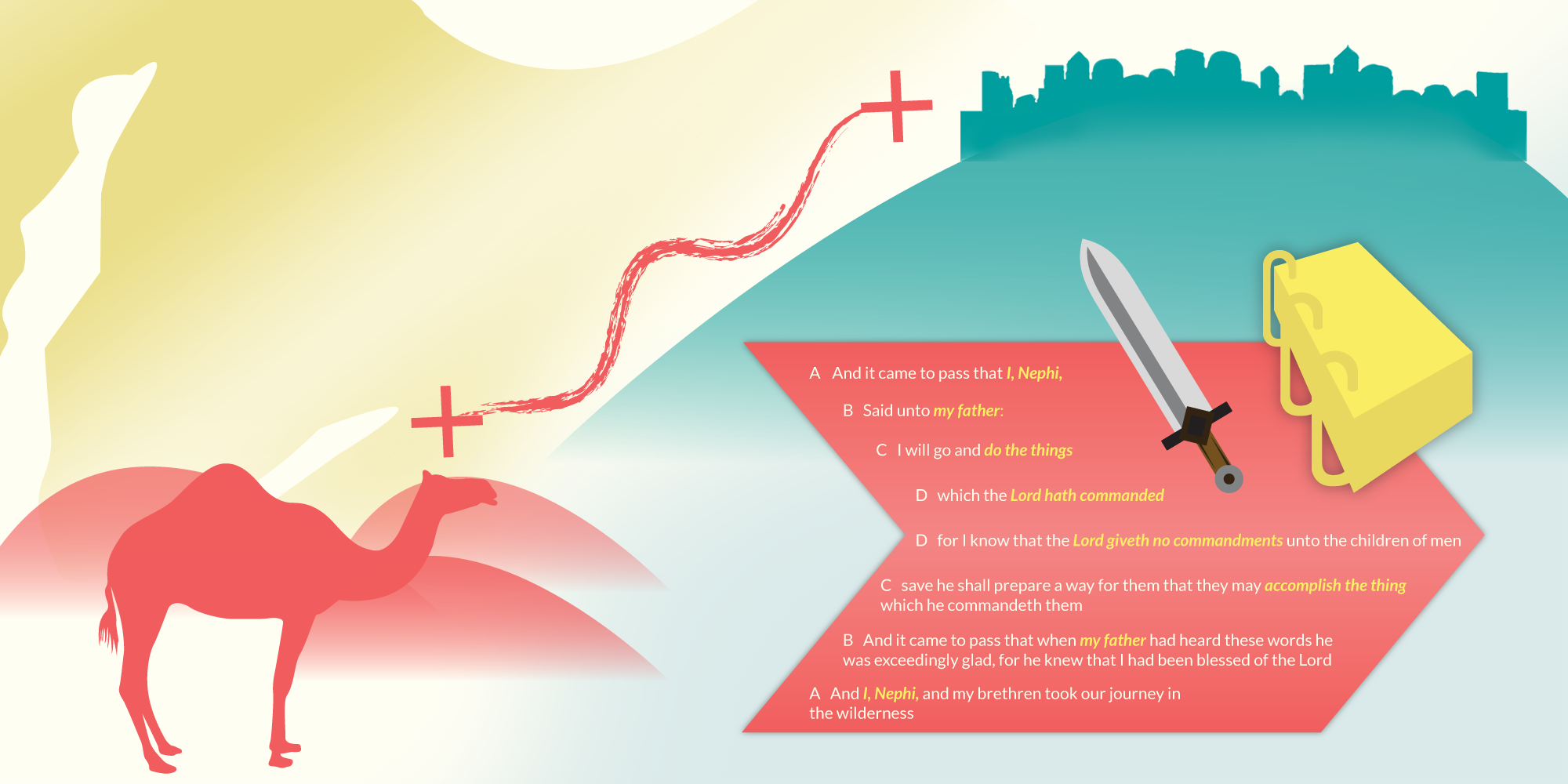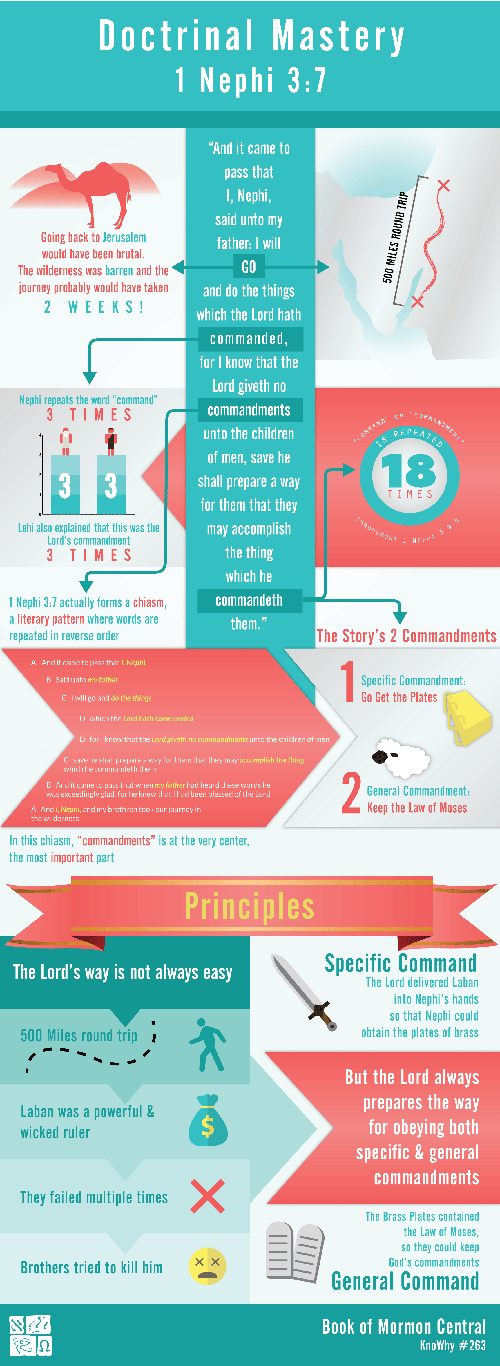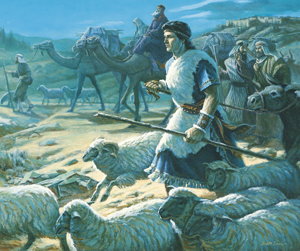You are here
Why Did Nephi Believe the Lord Would Prepare a Way?

1 Nephi 3:7
Context and Content
Click Image to Enlarge
Lehi’s family had just traveled about 250 miles through what some travelers called a “brutal wilderness” with long stretches of nothing but barren desert, where “hardly a blade of grass breaks up the monotony.”1 The journey would have taken about 2 weeks.2 And now, they were being asked to go back to retrieve the plates of brass from a short-tempered Jerusalem official with command of a military garrison (1 Nephi 3:4, 31).3 If Laman and Lemuel were right about anything, it is that they were asked to do a “hard thing” (1 Nephi 3:5).
Yet, as Lehi emphasized to Nephi, this hard thing was “commanded” of the Lord—repeating that point three times to be sure he understood (1 Nephi 3:2, 4, 5). Nephi had just returned from conversing with the Lord, where he was promised: “inasmuch as ye shall keep my commandments, ye shall prosper” (1 Nephi 2:20). Eager to hold up his end of this obligation, Nephi responded to his father with equal emphasis on commandments, likewise repeating the term three times in his one-verse reply (1 Nephi 3:7).4
This sets up the rest of the story about getting the plates, where the Lord’s commandments are central: command or commandment is repeated 18 times total in 1 Nephi 3 and 4.5 Affirming this, Nephi’s response that he will “go and do” is part of a chiasm—a literary pattern where key words, phrases, or ideas are repeated in reverse order.6 The center of a chiasm is usually the most important part, and Nephi’s chiasm has the Lord’s commandments at the very center.
Chiasmus in 1 Nephi 3:7–9
| A And it came to pass that I, Nephi, | |||
| B said unto my father: | |||
| C I will go and do the things | |||
| D which the Lord hath commanded | |||
| D for I know that the Lord giveth no commandments unto the children of men | |||
| C save he shall prepare a way for them that they may accomplish the thing which he commandeth them. | |||
| B And it came to pass that when my father had heard these words he was exceedingly glad, for he knew that I had been blessed of the Lord. | |||
| A And I, Nephi, and my brethren took our journey in the wilderness7 | |||
Two types of commandments are at play in this story. First, the story teaches about specific commandments given in a particular time and context—like getting the plates from Laban. Second, it teaches about general commandments that apply to everyone, like “the commandments of the Lord” found on the plates of brass (1 Nephi 4:15).
Obtaining the plates of brass was done in obedience to a specific commandment and was necessary so that Nephi’s seed could keep the general commandments given to all the house of Israel (1 Nephi 4:14–17).8
Doctrines and Principles
Nephi’s story highlights how the Lord prepares the way for obeying both types of commandments: (1) The Lord prepared a way for Nephi to obtain the plates of brass by delivering Laban into his hands (1 Nephi 4:10–12); (2) Obtaining the plates, which had the Law of Moses on them, prepared the way for Lehi’s family and their descendants to keep the commandments (1 Nephi 4:14–17).9
Lehi's Family Leaving Jerusalem by Scott Snow
Nephi is a model for keeping the commandments even when doing so is challenging and difficult. Although he had to travel 500 miles round trip in a scorching desert and face off with a powerful leader, Nephi was determined to obey. This is true of Nephi throughout his life.10 President Thomas S. Monson taught, “Though others faltered in their faith and their obedience, never once did Nephi fail to do that which the Lord asked of him. Untold generations have been blessed as a result.”11
Nephi’s story teaches that while the Lord may prepare the way, the way prepared is not always easy. It was not until Nephi and his brothers had made multiple failed attempts, and Nephi had suffered from violence at his brothers hands, that the Lord finally intervened (1 Nephi 3). Nephi had proven himself determined and willing to be “led by the Spirit” (1 Nephi 4:6), and thus a way was prepared.12
President Henry B. Eyring, of the First Presidency, taught that this kind of commitment comes from trusting in the Lord:
The young Nephi in the Book of Mormon stirs in us a desire to develop trust in the Lord to obey His commandments, however hard they appear to us. Nephi faced danger and possible death when he said these words of trust that we can and must feel steadily in our hearts … . That trust comes from knowing God.13
Nephi knew that the Lord would prepare a way for him because he trusted in Him, and he wrote the story about obtaining the plates to illustrate this truth. He placed the Lord’s commandments at the center of his response to his father, symbolizing their central importance to the whole story.
Further Reading
President Thomas S. Monson, “Obedience Brings Blessings,” Ensign, May 2013, 89–92.
President Henry B. Eyring, “Trust in God, Then Go and Do,” Ensign, November 2010, 70–73.
Elder Richard G. Scott, “To Acquire Spiritual Guidance,” Ensign, November 2009, 6–9.
- 1. George Potter and Richard Wellington, Lehi in the Wilderness: 81 New, Documented Evidences That the Book of Mormon is a True History (Springville, UT: Cedar Fort, 2003), 22, 41. For the distance between Jerusalem and the camp at the Valley of Lemuel, see S. Kent Brown, Voices from the Dust: Book of Mormon Insights (American Fork, UT: Covenant Communications, 2004), 3, 6; S. Kent Brown, “New Light from Arabia on Lehi’s Trail,” in Echoes and Evidences of the Book of Mormon, ed. Donald W. Parry, Daniel C. Peterson, and John W. Welch (Provo, UT: FARMS, 2002), 55.
- 2. Brown, Voices from the Dust, 3.
- 3. Ancient records tell stories of military governors in ancient Near Eastern cities behaving much like Laban did. See Hugh Nibley, Approaching the Book of Mormon (Salt Lake City and Provo, UT: Deseret News and FARMS, 1988), 120–131. See also, Hugh Nibley, Lehi in the Desert/The World of the Jaredites/There Were Jaredites, The Collected Works of Hugh Nibley, Volume 5 (Salt Lake City and Provo, UT: Deseret Book and FARMS, 1988), 97–98.
- 4. Joseph Spencer, An Other Testament: On Typology, 2nd edition (Provo, UT: Neal A. Maxwell Institute for Religious Scholarship, 2016), 84–85. Spencer pointed out that this story really starts with the covenant made in 1 Nephi 2:19–24, and that Lehi and Nephi both repeat some form of the term command(ed/eth/ment) three times, but his analysis goes in a different direction than what will be followed here.
- 5. Spencer, An Other Testament, 84–90 discusses the centrality of commandment in the Laban story, though he takes a different approach than that followed here. On the frequency of command or commandment, see 1 Nephi 3:2, 4, 5, 7 (3x), 15, 16 (2x), 18, 21; 4:1, 11, 15, 17, 20, 34.
- 6. See Book of Mormon Central, “Why is the Presence of Chiasmus in the Book of Mormon Significant? (Mosiah 5:10–12),” KnoWhy 166 (August 16, 2016). See also, John W. Welch, “Chiasmus in the Book of Mormon,” BYU Studies 10, no. 3 (1969): 69–83; John W. Welch, “Chiasmus in the Book of Mormon,” in Chiasmus in Antiquity: Structures, Analyses, Exegesis, ed. John W. Welch (Hildesheim: Gerstenberg Verlag, 1981; reprint Provo, UT: Research Press, 1999), 198–210; John W. Welch, “Chiasmus in the Book of Mormon,” in Book of Mormon Authorship: New Light on Ancient Origins, ed. Noel B. Reynolds (Provo, UT: Religious Studies Center, 1982: reprint Provo, UT: FARMS, 1996), 33–52.
- 7. Adapted from Donald W. Parry, Poetic Parallelisms in the Book of Mormon: The Complete Text Reformatted (Provo, UT: Neal A. Maxwell Institute for Religious Scholarship, 2007), 5–6.
- 8. Spencer, An Other Testament, 88–90 pointes out the two different types of commandments at work in the story, but has a different approach to their relationship in the story.
- 9. Monte S. Nyman, Book of Mormon Commentary, 6 vol. (Orem, UT: Granite, 2003), 1:57; Joseph Fielding McConkie and Robert L. Millet, Doctrinal Commentary on the Book of Mormon, 4 vols. (Salt Lake City, UT: Deseret Book, 1987–1992), 1:40.
- 10. See John A. Tvedtnes, “He Shall Prepare Away,” in The Most Correct Book: Insights from a Book of Mormon Scholar (Salt Lake City, UT: Cornerstone Publishing, 1999), 104–109.
- 11. President Thomas S. Monson, “Obedience Brings Blessings,” Ensign, May 2013, 90.
- 12. See Brant A. Gardner, Second Witness: Analytical and Contextual Commentary on the Book of Mormon, 6 vols. (Salt Lake City, UT: Greg Kofford Books, 2007), 1:101–102.
- 13. President Henry B. Eyring, “Trust in God, Then Go and Do,” Ensign, November 2010, 71.
KnoWhy Citation
Related KnoWhys
Subscribe
Get the latest updates on Book of Mormon topics and research for free







